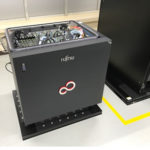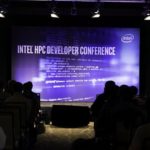“I think for the first time we have shown a proof of concept for embedded cooling for Department of Defense and potential commercial applications,” Garimella said. “This transformative approach has great promise for use in radar electronics, as well as in high-performance supercomputers. In this paper, we have demonstrated the technology and the unprecedented performance it provides.”
Archives for October 2017
Exascale to Enable Smart Cities
Over at Argonne, Charlie Catlett describes how the advent of Exascale computing will enable Smart Cities designed to improve the quality of life for urban dwellers. Catlett will moderate a panel discussion on Smart Cities at the SC17 Plenary session, which kicks off the conference on Monday, Nov. 13 in Denver.
Radio Free HPC Announces Project Cyclops for World’s Fastest Node
In this podcast, Dan Olds from OrionX describes Project Cyclops – a benchmarking quest to build the world’s fastest single node. “We’ve done more than 150 podcasts talking about topics in high performance computing,” said Dan Olds, partner at OrionX.net Research. “It was time we actually put something together and take a run at some of these benchmarks.”
Beowulf Bash Returns to Denver for SC17
The Beowulf Bash is returning to Denver for SC17. The event takes place at the Lucky Strike bowling alley on Monday, Nov. 13 from 9pm to 12 midnight. “Got an urge to try something new? Lucky Strike Denver has you covered. With a tantalizing menu of chef driven cuisine, hand-crafted cocktails, and live local DJs, Lucky Strike Denver breathes new life into the typical bowling experience with chic modern decor and a one-of-a-kind atmosphere.”
Video: What IBM’s 5 Nanometer Transistors Mean for You
In this video, Nicolas Loubet from IBM Research describes how IBM’s new 5 nanometer transistors will provide huge power savings that could enable mobile devices to run for days without a charge. “The resulting increase in performance will help accelerate cognitive computing, the Internet of Things (IoT) and other data-intensive applications delivered in the cloud.”
Banshee Makes DRAM Cache up to 50 percent more efficient
Researchers from MIT, Intel, and ETH Zurich have developed a new cache-management scheme that improves the data rate of in-package DRAM caches by 33 to 50 percent. “The bandwidth in this in-package DRAM can be five times higher than off-package DRAM,” says Xiangyao Yu, a postdoc in MIT’s Computer Science and Artificial Intelligence Laboratory and first author on the new paper. “But it turns out that previous schemes spend too much traffic accessing metadata or moving data between in- and off-package DRAM, not really accessing data, and they waste a lot of bandwidth. The performance is not the best you can get from this new technology.”
Fujitsu Deploys immersion-cooled x86 Cluster for JARI in Japan
Today Fujitsu announced the deployment of a immersion-cooled cluster at the Japan Automobile Research Institute (JARI). The new system will be used simulate automobile collisions. “Going forward, Fujitsu has plans to offer the liquid immersion cooling system worldwide as a product for cooling IT devices in non-conductive fluid.”
Cray Supercomputing Comes to Microsoft Azure
Today Cray announced a partnership with Microsoft to offer dedicated Cray supercomputing systems in Microsoft Azure. Under the partnership agreement, Microsoft and Cray will jointly engage with customers to offer dedicated Cray supercomputing systems in Microsoft Azure datacenters to enable customers to run AI, advanced analytics, and modeling and simulation workloads at unprecedented scale, seamlessly connected to the Azure cloud.
Register Now For the Intel HPC Developer Conference 2017
Powerful technologies today fuel tomorrow’s HPC and High-Performance Data Analytics innovations and help organizations accelerate toward discoveries. Get ahead of the curve at the Intel HPC Developer Conference 2017 in Denver, Colorado on November 11-12.
Challenges to Managing an HPC Software Stack
The HPC system software stack tends to be complicated, assembled out of a diverse mix of somewhat compatible open source and commercial components. This is the second article in a four-part series that explores using Intel HPC Orchestrator to solve HPC software stack management challenges. Download the full insideHPC Special Report.












